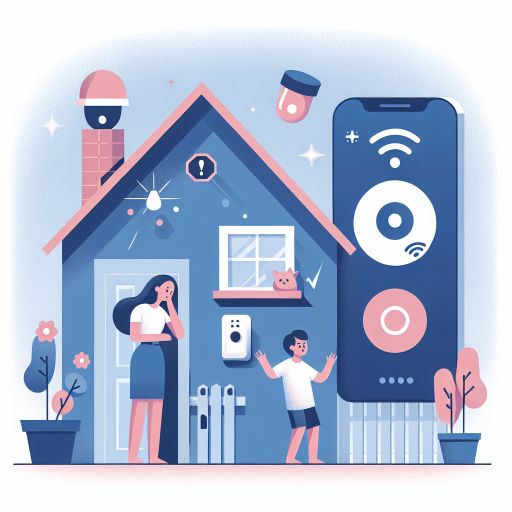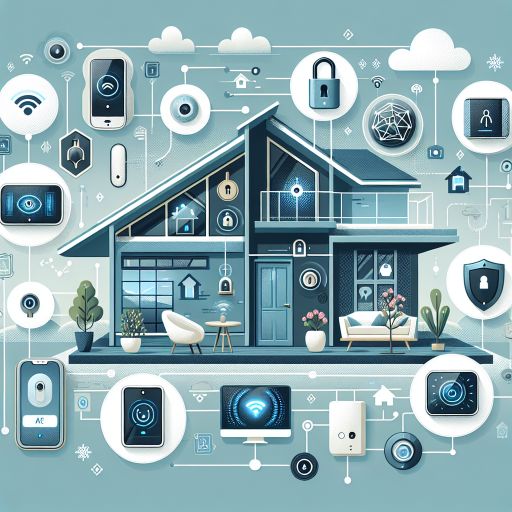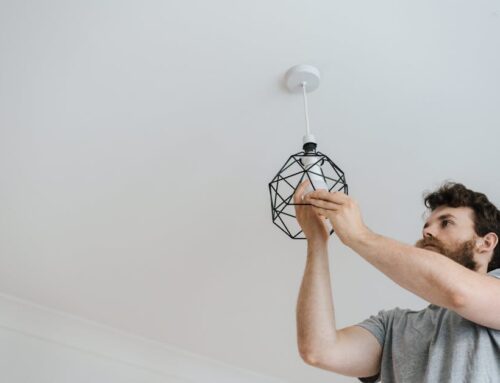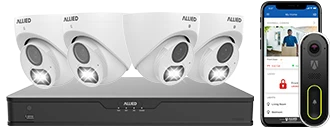Introduction to Home Alarm Monitoring Systems
Home alarm monitoring systems have become an integral part of home security, providing homeowners with peace of mind by ensuring their property is protected 24/7. These systems not only deter potential intruders but also offer immediate response capabilities in case of emergencies such as break-ins, fires, or medical incidents.
At their core, home alarm monitoring systems consist of sensors, control panels, and communication networks that work together to detect and respond to various threats. When a sensor is triggered, it sends a signal to the control panel, which processes the information and alerts a monitoring center or sends notifications directly to the homeowner.
There are several primary components in a typical home alarm monitoring system, each serving a specific role:
- Sensors: These devices detect unusual activity or dangerous conditions such as motion, door/window openings, smoke, or carbon monoxide levels.
- Control Panel: The central hub where information from sensors is processed and appropriate actions are initiated.
- Keypads and Control Devices: Interfaces allowing users to activate or deactivate the system, often including additional features like panic buttons.
- Communication Channels: Methods for transmitting alerts and data, which can include telephone lines, cellular networks, and internet connections.
- Monitoring Center: A dedicated facility where alerts are received and processed by trained professionals, who then dispatch emergency responders if necessary.
The effectiveness and reliability of home alarm monitoring systems depend on the type of sensors and the communication methods used. For instance, older systems may rely on traditional phone lines, while modern systems often utilize cellular or internet-based communication for faster and more reliable signal transmission.
The table below provides a comparison of different communication channels used in home alarm monitoring:
| Communication Channel | Characteristics |
|---|---|
| Telephone Line | Older technology, can be vulnerable to line cuts |
| Cellular Network | Reliable and faster, no physical lines required |
| Internet | High-speed communication, dependent on internet connection |
Each of these components and communication channels plays a crucial role in ensuring the timely and accurate detection of emergencies, making home alarm monitoring systems a vital component of modern home security strategies.
Key Components of Home Alarm Monitoring
Home alarm monitoring systems are composed of several key components that work together to ensure the security and safety of a property. Understanding these components is essential to grasp how the system functions as a whole.
Control Panel
The control panel serves as the central hub of a home alarm monitoring system. It communicates with all other components and sends alerts to the monitoring service. Modern control panels often come with a touchscreen interface, allowing users to easily arm or disarm the system, view statuses, and configure settings.
Sensors
Sensors are critical in detecting unauthorized entry or environmental hazards. There are several types of sensors used in home alarm monitoring systems, including:
- Door and Window Sensors: These sensors are placed on the frames of doors and windows. They trigger an alarm when the door or window is opened while the system is armed.
- Motion Sensors: Motion sensors detect movement within the home. They use technologies like infrared or microwave to identify changes in the environment.
- Glass Break Sensors: These sensors detect the sound or vibration of breaking glass, providing an additional layer of security against intruders.
- Environmental Sensors: These sensors monitor for hazards such as smoke, carbon monoxide, and water leaks.
Alarms
Alarms are activated when a sensor detects something unusual. There are different types of alarms, each serving a specific purpose:
- Audible Alarms: These alarms produce loud sounds to alert occupants and deter intruders.
- Silent Alarms: These alarms notify the monitoring service without alerting the intruder, allowing for a discreet response.
Communication Methods
Communication methods are crucial for transmitting alerts from the control panel to the monitoring service. Key communication methods include:
- Landline: Uses a traditional phone line to send alerts.
- Cellular: Uses a cellular network for a more modern and reliable communication method.
- Internet: Uses a broadband connection to send signals over the internet.
Monitoring Service
The monitoring service is a professional service that receives alerts from the control panel and takes appropriate action. This might involve contacting the homeowner, dispatching emergency services, or both.
Backup Power
A reliable home alarm monitoring system includes a backup power source, typically a rechargeable battery, to ensure that the system remains operational during power outages.
By integrating these components, a home alarm monitoring system provides comprehensive security, reducing the risk of unauthorized entry and environmental hazards.
Types of Home Alarm Monitoring Services
When it comes to home alarm monitoring services, understanding the different types available is crucial for choosing the best option to ensure your home’s security. Primarily, these services can be categorized into three major types: professionally monitored, self-monitored, and unmonitored systems.
Professionally Monitored Systems
Professionally monitored systems involve a third-party service that oversees your home security 24/7. When an alarm is triggered, these monitoring centers receive an alert and take appropriate actions such as contacting the homeowner, notifying the police, or dispatching emergency services. Notable providers of such services include ADT, Vivint, and Frontpoint.
Advantages:
- Constant professional monitoring, providing peace of mind.
- Quick response time in case of emergencies.
- Potential discounts on homeowner’s insurance.
Dis
advantages:
- Recurring monthly fees can be expensive.
- Potential for false alarms leading to unnecessary emergency responses.
Self-Monitored Systems
Self-monitored systems allow the homeowner to monitor their security via mobile apps, SMS, or email notifications. When an alarm is triggered, the system sends an alert directly to the homeowners, who then decide the next course of action. Some popular self-monitored systems include SimpliSafe, Ring, and Nest Secure.
Advantages:
- No recurring monthly fees, making it a cost-effective option.
- Direct control over home security and response actions.
- Easy to install and maintain.
Disadvantages:
- Reliance on the homeowner to respond promptly to alerts.
- Potentially slower response times in emergencies.
Unmonitored Systems
Unmonitored systems, also known as local alarm systems, activate local alarms, such as loud sirens or flashing lights, when triggered. They do not connect to a monitoring center or send alerts to homeowners. These systems aim to deter intruders through loud, attention-grabbing alarms.
Advantages:
- No ongoing costs apart from initial installation expenses.
- High deterrence factor due to loud alarms.
- Simple setup and operation.
Disadvantages:
- No remote notifications or professional intervention.
- Reliance on neighbors or nearby individuals to respond to the alarm.
- Limited effectiveness if no one is around to hear the alarm.
Each type of home alarm monitoring service has its own set of advantages and disadvantages. The choice between professionally monitored, self-monitored, or unmonitored systems depends on individual needs and preferences, including considerations of cost, convenience, and the desired level of security oversight.
Installation and Setup Process
The installation and setup process for home alarm monitoring systems is crucial for ensuring that the system operates efficiently and provides the intended security. This chapter will detail the steps involved, from initial planning to activation, and provide an overview of what homeowners can expect during the process.
Initial Assessment and Planning
The first step involves an initial assessment of the home. This typically includes identifying vulnerable points such as doors, windows, and other entry points. A professional installer or the homeowner can carry out this assessment.
- Identify entry points: doors, windows, basement entrances.
- Evaluate existing security measures.
- Plan the placement of sensors and cameras.
Installation of Hardware
After the assessment, the next step is the installation of hardware components. This includes sensors, cameras, control panels, and other devices. This phase is usually done by professional installers to ensure proper setup and functionality.
The following table outlines common hardware components and their typical installation locations:
| Component | Installation Location |
|---|---|
| Motion Sensors | Corners of rooms and hallways |
| Door/Window Sensors | Door and window frames |
| Security Cameras | Entrance points, living rooms, outside perimeters |
| Control Panel | Near entrance or central location |
System Configuration
Once the hardware is installed, the system configuration begins. This includes setting up the control panel, connecting the system to a secure network, and integrating it with any existing smart home devices.
- Program user codes and access levels.
- Set up communication with the monitoring center.
- Customize alert settings and notifications.
- Integrate with mobile devices for remote access.
Testing and Activation
After configuration, the system undergoes a thorough testing phase to ensure all components are functioning as intended. The installer will test sensors, cameras, and the control panel to verify their proper operation.
- Test each sensor and camera individually.
- Verify control panel and remote access functionality.
- Ensure reliable communication with the monitoring center.
Once testing is complete, the system is activated and ready for use. Initial instructions on how to operate the system, manage alerts, and respond to notifications are provided to the homeowner.
Maintenance and Support
Ongoing maintenance and support are essential for the long-term reliability of the home alarm monitoring system. This may include regular software updates, hardware checks, and customer support services from the provider.
- Scheduled maintenance visits.
- Software and firmware updates.
- 24/7 customer support for troubleshooting and assistance.
Benefits and Drawbacks of Home Alarm Monitoring
Home alarm monitoring systems offer a range of benefits but also come with certain drawbacks.
Understanding these aspects can help homeowners make informed decisions about implementing such a system.
Benefits of Home Alarm Monitoring:
- Enhanced Security: A primary advantage is the improved security for homes. These systems can deter burglars and rapidly alert authorities in the event of a break-in.
- 24/7 Monitoring: Many alarm monitoring services provide continuous surveillance, ensuring protection at all times, regardless of whether the homeowner is present.
- Quick Response Times: Monitored systems can lead to faster emergency response times. Monitoring centers can quickly notify police, fire departments, or medical services when alarms are triggered.
- Insurance Discounts: Some insurance companies offer lower premiums for homes equipped with alarm monitoring systems, as the risk of theft or damage is reduced.
- Remote Access: Many modern systems offer remote access, allowing homeowners to monitor and control their security system via smartphones or computers.
Drawbacks of Home Alarm Monitoring:
- Cost: One of the significant drawbacks is the cost. Home alarm monitoring services often require a monthly subscription fee, which can add up over time.
- False Alarms: False alarms can be problematic. These can occur due to user error, equipment malfunction, or other factors, potentially leading to fines or unnecessary dispatch of emergency services.
- Privacy Concerns: Some homeowners may have concerns about privacy, as monitored systems involve sharing data with third parties, including the monitoring service provider.
- Dependence on Power and Internet: Many modern systems rely on electricity and internet connections. Power outages or internet service disruptions can affect the functionality of the system.
- Contracts: Some monitoring services require long-term contracts, which may be difficult to cancel without incurring penalties.
In conclusion, while home alarm monitoring systems offer significant security enhancements and peace of mind, homeowners must weigh these benefits against the costs and potential drawbacks to determine if such a system is the right fit for their needs.
Cost Analysis and Budget Considerations
When considering the implementation of a home alarm monitoring system, an essential aspect to understand is the associated costs and budget considerations. This chapter delves into the various expenses one might encounter, including initial costs, recurring expenses, and potential hidden fees.
Initial Costs
The initial costs of a home alarm monitoring system typically include the purchase of equipment and installation fees. These costs can vary widely based on the complexity and brand of the system chosen.
- Equipment Costs: Basic alarm systems can start as low as $100, while more advanced systems with additional sensors and features can exceed $1,000.
- Installation Fees: Professional installation fees can range from $50 to over $200 depending on the extent of the setup required.
Recurring Expenses
After the initial setup, ongoing costs are mainly comprised of monthly monitoring fees. These fees can vary based on the level of service provided.
- Basic Plans: Typically range from $10 to $30 per month and may include essential monitoring services.
- Advanced Plans: Can range from $30 to $60 per month and may offer additional features such as video surveillance, mobile app access, and home automation integrations.
Potential Hidden Fees
Understanding potential hidden fees is necessary to avoid unexpected expenses. These can include:
- Activation Fees: Some service providers charge a one-time activation fee, which can range from $20 to $100.
- Service Call Fees: If troubleshooting or repairs are required, service call fees can range from $50 to $100 per visit.
- Early Termination Fees: If the user decides to cancel the service before the contract period ends, early termination fees can be imposed ranging from $200 to $500.
Cost Comparison Table
| Expense Type | Cost Range |
|---|---|
| Equipment Costs | $100 – $1,000+ |
| Installation Fees | $50 – $200+ |
| Basic Monthly Monitoring Fee | $10 – $30 |
| Advanced Monthly Monitoring Fee | $30 – $60 |
| Activation Fees | $20 – $100 |
| Service Call Fees | $50 – $100 |
| Early Termination Fees | $200 – $500 |
Budget
Considerations
When planning a budget for a home alarm monitoring system, it is crucial to consider both upfront and ongoing costs. Assessing the importance of additional features versus basic functionality can help homeowners make an informed decision aligning with their financial situation.
Additionally, it is beneficial to research and compare multiple service providers to find the best balance between cost and features. Many companies offer promotions or discounted rates for signing long-term contracts, which can help reduce overall expenses.
Future Trends in Home Alarm Monitoring
7. Future Trends in Home Alarm Monitoring
The home alarm monitoring industry is evolving rapidly, influenced by advancements in technology and changes in consumer behavior. This chapter will explore some of the most significant future trends expected to shape the landscape of home alarm monitoring.
Integration with Smart Home Technology
One of the most notable trends is the integration of home alarm systems with smart home technology. Devices such as smart locks, video doorbells, and voice-activated assistants like Amazon Alexa and Google Home are increasingly compatible with home alarm systems. This integration allows for more seamless control over home security, providing users the ability to monitor and manage their security systems through centralized platforms.
- Remote access and control via smartphone apps
- Automated responses to security breaches
- Enhanced user experience with voice commands
Artificial Intelligence and Machine Learning
Artificial intelligence (AI) and machine learning (ML) are playing a transformative role in home alarm monitoring. These technologies help in improving the accuracy and effectiveness of security systems by learning from past patterns and predicting potential security threats.
- Advanced facial recognition for identifying authorized and unauthorized persons
- Behavioral analysis to detect unusual activities
- Predictive analytics for anticipating security incidents
Cybersecurity Integration
As home alarm systems increasingly rely on internet connectivity, cybersecurity becomes a crucial aspect of home security. Future home alarm systems will likely incorporate more robust cybersecurity measures to protect against hacking and other cyber threats.
- Encryption of data transmissions
- Regular software updates to patch vulnerabilities
- Integration with VPNs for secure remote access
Enhanced Communication Protocols
Communication technologies are also expected to see substantial improvements. Future home alarm systems will likely utilize more advanced communication protocols to ensure faster and more reliable alerts and responses.
- 5G technology for quicker data transmission
- Redundant communication channels for failsafe operations
- Integration with emergency services for streamlined responses
Environmental Monitoring
Besides traditional security threats, modern home alarm systems are starting to include environmental monitoring features. These capabilities help in detecting issues such as fire, carbon monoxide, and water leaks.
- Smoke and carbon monoxide detectors integrated into the system
- Water leak sensors to prevent flooding
- Temperature and humidity sensors for environmental control
Conclusion
The future of home alarm monitoring is promising, with numerous advancements enhancing the security and convenience for homeowners. As technologies continue to evolve, home alarm systems will become more integrated, intelligent, and resilient, providing a more comprehensive approach to home security.













